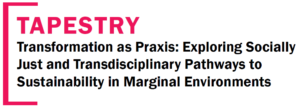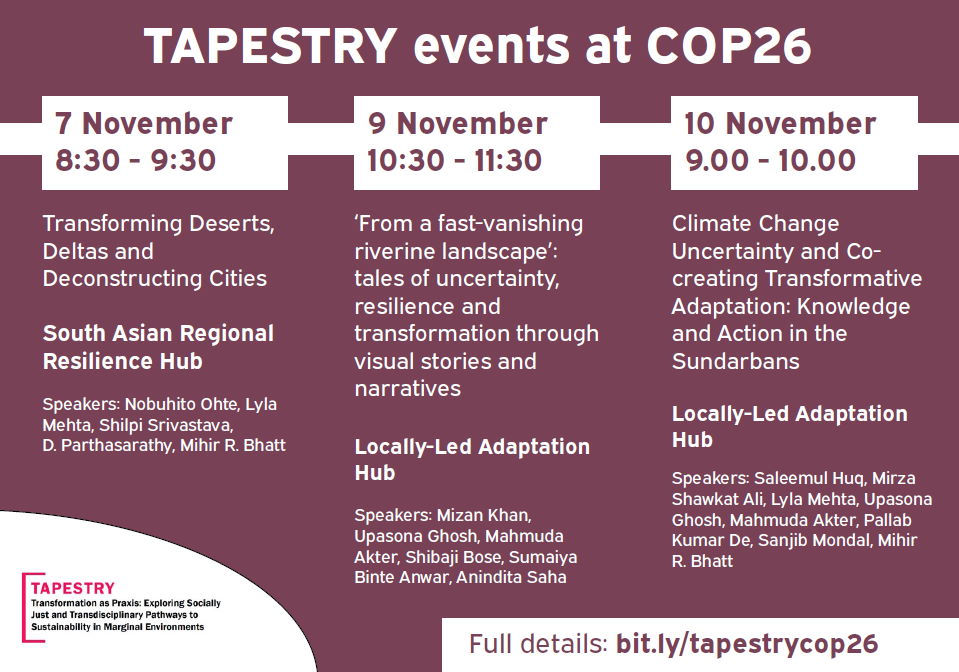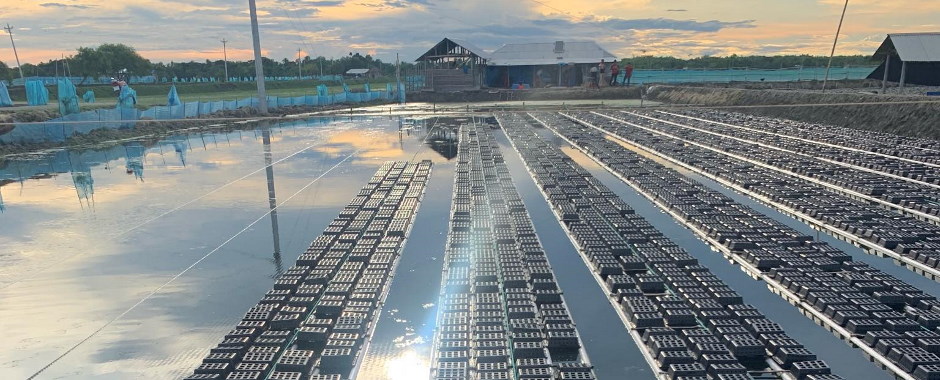 The TAPESTRY project is hosting three side events at the COP26 conference in Glasgow, November 2021.
The TAPESTRY project is hosting three side events at the COP26 conference in Glasgow, November 2021.
Transforming Deserts, Deltas and Deconstructing Cities
7 November at 8:30-9:30 am
South Asian Regional Resilience Hub
‘From a fast-vanishing riverine landscape’: tales of uncertainty, resilience and transformation through visual stories and narratives
9 November 2021 at 10:30-11:30
Locally-Led Adaptation Hub
Climate Change Uncertainty and Co-creating Transformative Adaptation: Knowledge and Action in the Sundarbans
10 November at 9.00-10.00
Locally-Led Adaptation Hub

About the events
Transforming Deserts, Deltas and Deconstructing Cities
7 November at 8:30-9:30 am (UK time / GMT)
South Asian Regional Resilience Hub
Speakers: Nobuhito Ohte, Lyla Mehta, Shilpi Srivastava, D. Parthasarathy, Mihir R. Bhatt
- Lyla Mehta, Institute of Development Studies
- Shilpi Srivastava, Institute of Development Studies
- D. Parthasarathy, Indian Institute of Technology, Bombay
- Mihir R. Bhatt, All India Disaster Mitigation Institute
This event explores how transformation may arise ‘from below’ in marginal environments with high levels of climate change uncertainty. Transformative alliances between actors (local communities, NGOs, scientists and state agencies), in marginal environments in India, are seeking socially just and ecologically sound alternatives based on local people’s plural understandings of what transformation entails. These ‘patches’ or areas of transformation have the potential to grow or merge with others.
- The dryland of Kutch counts among the world’s most variable and unpredictable environments. Local herder communities have learnt how to live with and harness this variability to support sustainable and productive economies and ecosystems by drawing on and developing their indigenous knowledge systems. Synergistic links between the Mangroves, Mal (livestock), and Maldharis (pastoralists), are crucial for responding to climate induced uncertainties.
- In Mumbai, major drainage channels remain obstructed and sky-high real estate prices drive contractors to appropriate and develop land in low-lying and flood prone zones. All of these aggravate threats from natural disasters and reveal a structurally unequal city wherein the poor, who constitute a large proportion of the city’s population, regularly face the brunt from the double impacts of development interventions (e.g displacement, loss of livelihoods) and flooding.
- Our understanding of changing climate and uncertainties are not only divided across locations and sectors, but from the levels – top-middle-bottom – as well, so as to have coherence of action and impact that is transformative. Drawing from the field work and related insights, we share some key action areas that can aim to bridge the gaps to achieve greater coherence and impact, with focus on aspects of gender, livelihood, wellbeing, and use of geospatial technologies.
‘From a fast-vanishing riverine landscape’: tales of uncertainty, resilience and transformation through visual stories and narratives
9 November 2021 at 10:30-11:30 (UK time / GMT)
Locally-Led Adaptation Hub
Speakers:
- Mizan Khan
- Upasona Ghosh
- Mahmuda Akter
- Shibaji Bose
- Sumaiya Binte Anwar
- Anindita Saha
The session will aim to sketch issues of vivencia (lived experiences) representing climate change, uncertainty and transformative actions in Sundarbans at the confluence of the delta and the Bay of Bengal, the single largest mangrove patch of the world spread across about 10,300 sq km of which about 60 percent is in Bangladesh and the rest in India. The visuals and narratives from this World Heritage site are representative of the stories of its 7.2 million ( half of them below poverty line) who dependent on – climate-sensitive sectors – agriculture, fishing, and collection of minor forest produce; Of the subsistence economy turning into a remittance economy since the people and the productivity of their holdings are under increased threat from deltaic subsidence, sea level rise, and increased cyclone intensity as climate change and decay of the 18th century embankments take their toll. The participants of these visual methods tell how climate change has adversely impacted farmers and fishermen alike with unpredictable rainfall patterns continue to make traditional crop production difficult for farmers. The stories are replete with the uncertainty and their resilience in the backdrop of an ecosystem being adversely impacted by significant increases in salinity due, in part, to sea level rise as well as reductions in freshwater flows to the delta. Rising sea levels place more pressure on agriculture as land continues to be lost to sea. Entire islands have disappeared under the sea necessitating human relocation and residents express concern that the frequency and intensity of storms and cyclones have increased overtime in the region.
Through photos and narratives, the stories of history and sense of place will be told from the vantage point of women, youth and children in the Sundarbans that are at the forefront of climate change and its uncertainty. The stories by the communities, through visual methods like children’s paintings, photovoice and digital photo diaries facilitates an engaged process of building knowledge thus supporting robust public and civil society engagement that can eventually foster positive social change from below. It enables these marginal communities of practice to contribute experiential knowledge, thus providing an embedded understanding of a phenomenon and thereby facilitating a shared responsibility for taking action. As a part of broader agenda of community participation and co-production, stories through visual methods seeks to forge knowledge about their local perspectives and facilitates engagement with the rich local traditions and cultures offers a robust scope for opening of a democratic space for dialogue and debate among various climate actors.
These stories not only aim or predict change but are able to understand, reimagine and transform reality in the context of socio-political transformations in these marginal landscapes. The session is also fundamental to both understanding resilience and building the shared vision of resilience and transformation at the local level. The photos and narratives synthesise local experience and organise shared collective analysis of the relationships between problems and their causes. The process of reflection and reflexivity is directly linked to action for climate justice and is shaped by an understanding of history, culture and local context. This provides a scope for co-creation of knowledge to support inclusion in policy, to systemise experience and draw out priorities for socially just transformations.
Climate Change Uncertainty and Co-creating Transformative Adaptation: Knowledge and Action in the Sundarbans
10 November at 9.00-10.00
Locally-Led Adaptation Hub
Speakers:
- Saleemul Huq, International Centre for Climate Change and Development
- Mirza Shawkat Ali, Director of Climate Change and Int’l Conversation (TBC)
- Lyla Mehta, Institute of Development Studies, UK
- Upasona Ghosh, Indian Institute of Public Health, Bhuaneshwar, India
- Mahmuda Akter, International Centre for Climate Change and Development
- Pallab Kumar De, Caritas, India and Sanjib Mondal, Caritas Bangladesh
- Local level stakeholders from both Bangladesh and India
- Sumaiya Binte Anwar, International Centre for Climate Change and Development
- Mihir R. Bhatt, All India Disaster Mitigation Institute, India
The Sundarbans remains one of the most complex and vulnerable areas in South Asia and an area where multiple socio-ecological challenges converge. It brings together issues such as sea level rise; delta management; collaborative role of India and Bangladesh in adaptation measures; large scale displacement; adaptive livelihood; and managed retreat. However, as this delta area is divided between India and Bangladesh, the action and research initiatives remain partial and recommendations become fractured. One way to address these challenges is to find ways to co-create studies on Sundarbans across the national boundaries, so that transformative knowledge and action become possible in one of the most important locations in South Asia.
The aim of this event is to share insights from recent and ongoing work both in the Indian and Bangladesh Sundarbans. The session is informed by the TAPESTRY project, which has over six years of experiences of action research around uncertainty and transformation, with a focus on livelihood and gender, in the Sundarbans delta. Co-creation of knowledge with researchers by local leaders blur the boundaries—geo-political and knowledge and ecological—between the two parts of Sundarbans delta. As there are as many similarities as there are dissimilarities, the ongoing collaborative research work explores multiple Sundarbans, simultaneous economic and ecological influences, as well as various ways these influences are interpreted or contextualised by the local and non-local individuals. Ultimately, the project seeks to understand and help support emerging ‘patches’ of transformations, working with local partner institutions for transformative knowledge and action.
Find out more
Visit the TAPESTRY project pages for publications and other resources.
